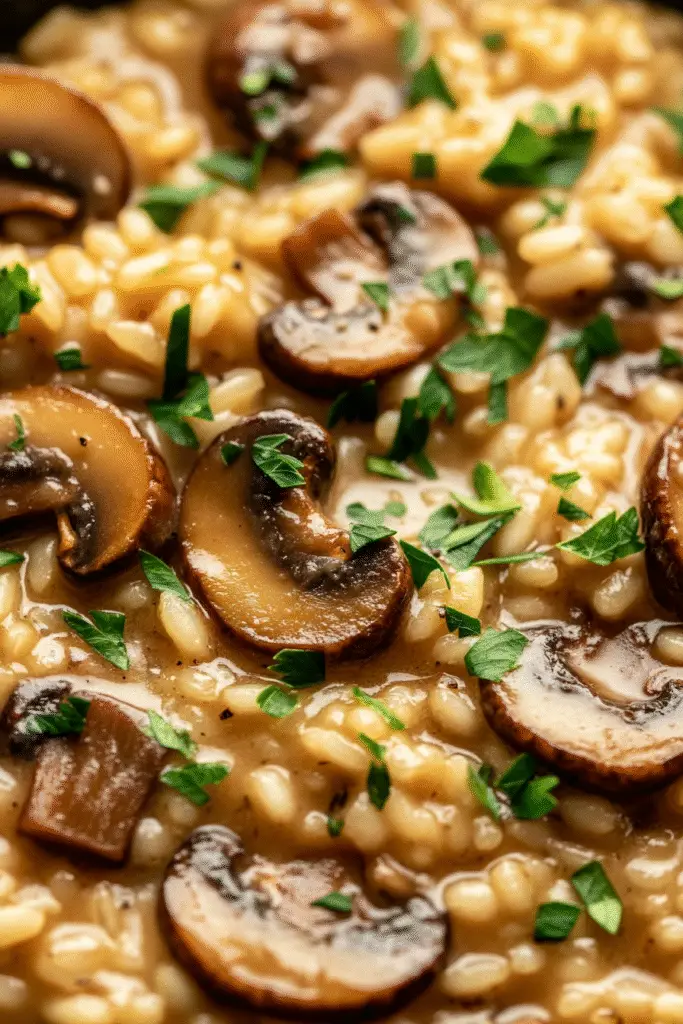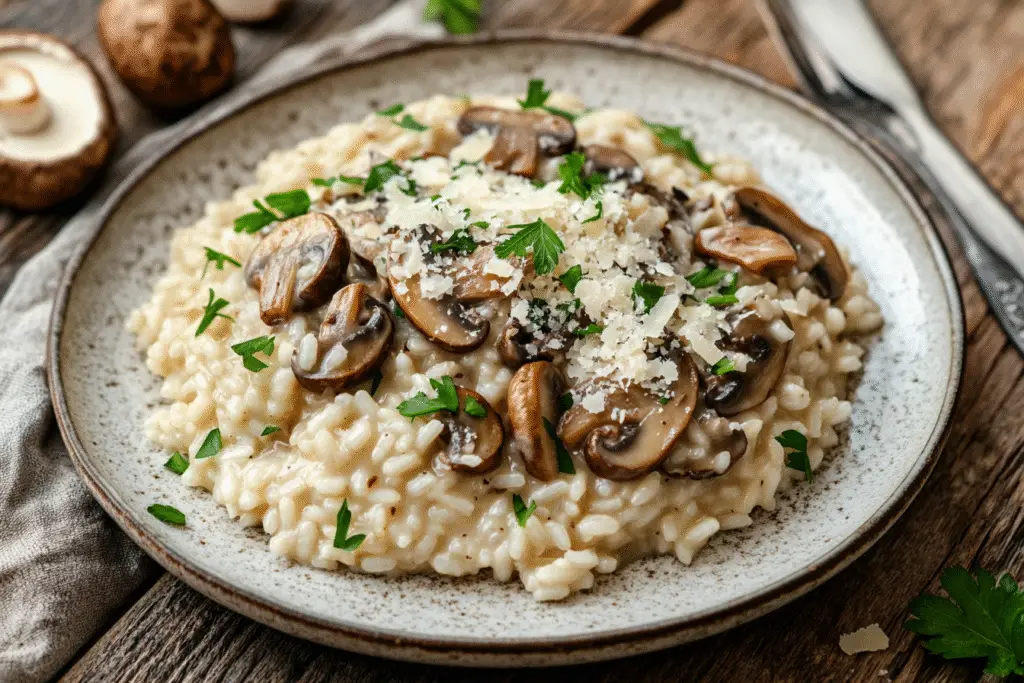Mushroom Risotto is the ultimate Italian comfort food—creamy, savory, and luxuriously satisfying with each spoonful. The magic of risotto lies in its velvety texture, the slow release of starches from the rice, and the way the earthy mushrooms harmonize with Parmesan cheese and aromatic broth. Though it has a reputation for being labor-intensive, this dish is more approachable than you might think when you follow key techniques carefully.
In this detailed guide, we’ll explore every step of creating perfect mushroom risotto, from selecting the best rice and mushrooms to mastering the stirring technique and building balanced flavors. I’ll also cover troubleshooting tips, preparation strategies, and creative variations to help you confidently make this restaurant-worthy dish at home.
Why Mushroom Risotto Works: Creamy Texture Meets Earthy Depth
The beauty of mushroom risotto is in its simple ingredients elevated through technique.
Core Elements:
- Arborio rice: Releases starches that create the risotto’s signature creamy texture without added cream.
- Sautéed mushrooms: Bring rich, earthy umami that complements the rice.
- Savory broth: Gradually absorbed by the rice, building flavor over time.
- Parmesan cheese: Adds nutty, salty richness.
Each bite is a luxurious balance of creaminess, tender rice, and deeply savory mushroom flavor.

Choosing the Best Rice for Risotto
The rice is the foundation of risotto. Not all rice types will work.
Ideal Rice:
- Arborio rice: The most commonly used; plump grains that release starch easily.
- Carnaroli rice: Preferred by many chefs for its creaminess and slightly firmer bite.
- Vialone Nano: Small, round grains that yield a very creamy texture.
Key Tip:
Never rinse risotto rice. You want to retain the natural starch on the grains to develop the creamy sauce.

Selecting the Right Mushrooms: Depth and Variety
Using a mix of mushrooms creates complexity and depth of flavor.
Recommended Varieties:
- Cremini (Baby Bella): Richer flavor than white mushrooms.
- Shiitake: Adds meatiness and subtle smokiness.
- Portobello: Provides a hearty bite and umami.
- Oyster mushrooms: Delicate flavor and interesting texture.
- White button mushrooms: Can be used but have a milder taste.
Key Tip:
Sauté mushrooms until golden and their moisture is fully evaporated to maximize flavor.

Broth Selection: Building Flavor Gradually
The broth is absorbed by the rice over time, so its flavor really matters.
Best Options:
- Vegetable broth: Great for a lighter, vegetarian risotto.
- Chicken broth: Provides a heartier base.
- Mushroom broth: Amplifies the mushroom flavor beautifully.
Pro Tip:
Warm the broth in a separate pot and add it to the risotto hot—this keeps the cooking process smooth and consistent.
Recommended Equipment
- Wide, heavy-bottomed sauté pan or Dutch oven: Helps with even heat distribution.
- Small saucepan: For warming the broth.
- Wooden spoon: Ideal for gently stirring risotto.
- Ladle: For adding broth in small increments.
Optional: Microplane for finely grating Parmesan.
Common Mistakes and How to Avoid Them
1. Sticky or Gummy Risotto
- Caused by over-stirring or too much heat.
- Solution: Stir regularly but gently; keep heat at a steady simmer.
2. Dry Risotto
- Happens when broth isn’t added gradually or not enough broth is used.
- Solution: Keep adding broth in small ladles, allowing the rice to absorb it fully before adding more.
3. Undercooked or Overcooked Rice
- Undercooked: Broth not absorbed long enough.
- Overcooked: Rice loses its bite and texture.
- Solution: Test the rice regularly; the grains should be tender with a slight chew.
4. Bland Flavor
- Can happen if the broth is weak or mushrooms aren’t properly sautéed.
- Solution: Use a rich broth, sauté mushrooms until well-browned, and season in layers.
Preparation and Meal Planning Tips
Make-Ahead Strategies:
- Broth can be prepared or enhanced ahead of time.
- Mushrooms can be sautéed in advance and added toward the end.
Reheating:
- Risotto is best fresh but can be gently reheated with a splash of broth or water to restore creaminess.
Meal Prep:
- Leftovers can be transformed into arancini (risotto balls) the next day.
Flavor Variations and Creative Add-Ins
Herb Enhancements:
- Fresh thyme, sage, or parsley add brightness.
- A hint of lemon zest lifts the richness.
Cheese Options:
- Parmesan is classic, but you can use Pecorino Romano for a saltier, sharper note.
Protein Additions:
- Grilled chicken or sautéed shrimp can turn this into a hearty main course.
- Crispy pancetta or bacon for extra savory depth.
Vegan Option:
- Use vegetable broth, olive oil instead of butter, and nutritional yeast instead of Parmesan.
Ingredient List
For the Risotto:
- 5 cups (1.2 liters) vegetable, chicken, or mushroom broth
- 2 tablespoons olive oil
- 1 tablespoon unsalted butter
- 1 small onion, finely chopped
- 4 cloves garlic, minced
- 1 ½ cups (300 g) Arborio rice
- 1 cup (150 g) mixed mushrooms, sliced
- ½ cup (120 ml) dry white wine (optional)
- ¾ cup (75 g) freshly grated Parmesan cheese
- Salt and black pepper to taste
Optional:
- 1 teaspoon fresh thyme leaves
- 1 tablespoon lemon zest
- Fresh parsley for garnish
- Additional butter for extra richness
Step-By-Step Instructions
1. Warm the Broth
Place broth in a saucepan over low heat and keep it warm throughout cooking.
2. Sauté the Mushrooms
In a large skillet, heat olive oil over medium heat.
Add sliced mushrooms and sauté for 7–9 minutes until golden and moisture is evaporated.
Season lightly with salt and pepper. Remove mushrooms and set aside.
3. Cook the Aromatics
In the same pan, melt butter over medium heat.
Add chopped onion and cook until softened, about 4 minutes.
Add minced garlic and cook for another 30 seconds until fragrant.
4. Toast the Rice
Stir in Arborio rice and cook for 1–2 minutes, stirring to coat the grains and lightly toast them.
Optional: Add white wine and stir until mostly absorbed.
5. Build the Risotto
Add warm broth one ladle at a time, stirring gently until each addition is almost fully absorbed before adding the next.
Continue this process for about 20–25 minutes until the rice is tender but still has a slight bite.
6. Finish the Risotto
Stir in sautéed mushrooms, Parmesan cheese, and optional thyme and lemon zest.
Season to taste with salt and pepper.
Optional: Stir in a tablespoon of butter for extra creaminess.
7. Serve
Spoon into bowls and garnish with fresh parsley and additional Parmesan.
Serve immediately for the best texture.
Troubleshooting and FAQs
How do I know when risotto is done?
The rice should be tender but still have a slight firmness in the center (al dente). The risotto should flow on the plate—it should not be dry or clumpy.
Can I make risotto without wine?
Absolutely. Wine adds acidity but can be skipped. Replace with a bit of extra broth.
How do I make risotto creamy without dairy?
The rice’s natural starch creates creaminess. For a dairy-free version, skip the cheese and butter and stir in olive oil or a vegan Parmesan alternative.
Can I freeze risotto?
Not recommended. Risotto changes texture significantly when frozen and reheated. It’s best enjoyed fresh.
Variations: Classic, Vegan, and Protein-Enhanced Versions
| Version | Broth | Cheese | Key Notes |
|---|---|---|---|
| Classic | Chicken or vegetable | Parmesan | Traditional, creamy, and savory |
| Vegan | Vegetable | Nutritional yeast | Plant-based, dairy-free |
| Protein | Chicken broth | Parmesan | Add shrimp, chicken, or pancetta |
Each variation delivers a comforting risotto base that can be easily customized to your taste.
Storage and Reheating Tips
- Storage: Refrigerate in an airtight container for up to 3 days.
- Reheating: Gently reheat with a splash of broth or water to restore creaminess.
- Freezing: Not ideal, but can be frozen for arancini or risotto cakes.
Final Thoughts
Mushroom Risotto is a simple yet sophisticated dish that rewards patience with rich, comforting flavors. The slow, mindful cooking process may seem time-consuming, but it’s actually relaxing and completely achievable at home.
Whether you keep it classic, make it vegan, or add your favorite proteins, this risotto is a versatile, elegant meal that feels both indulgent and nourishing. I hope this guide helps you perfect your mushroom risotto—feel free to personalize it with herbs, spice, or your favorite mix-ins!
